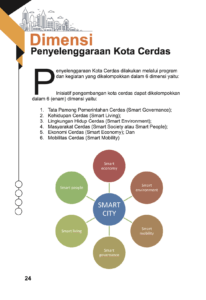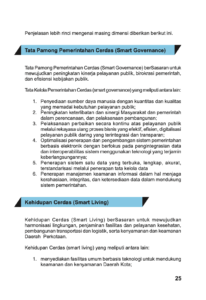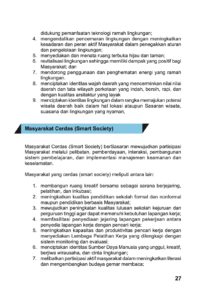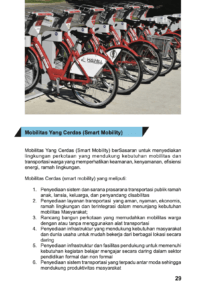Smart City implementation is carried out through programs and activities grouped into 6 dimensions, namely:
Smart city development initiatives can be grouped into 6 (six) dimensions, namely:
- Smart Governance;
- Smart Living;
- Smart Environment;
- Smart Society or Smart People;
- Smart Economy; And
- Smart Mobility
A more detailed explanation of each dimension is given below.
Smart Governance
Smart Governance aims to improve the performance of public services, government bureaucracy and the efficiency of public policy.
Smart Governance which includes, among others:
- Provision of human resources with sufficient quantity and quality for public service needs;
- Increasing the involvement and synergy of the community and government in planning and implementing development;
- Implementation of continuous improvements to public services through re-engineering of effective, efficient business processes, digitalization of integrated and transparent online public services;
- Optimizing the implementation and development of electronic-based government systems by focusing on data integration and system interoperability using technology whose sustainability is guaranteed;
- Implementation of a single data system that is open, complete, accurate, standardized through the implementation of data governance
- Implementation of information security management in terms of maintaining confidentiality, integrity and availability of data in supporting government systems.
Smart Living
Smart Living is aimed at realizing environmental harmonization, guaranteeing health facilities and services, developing transportation and logistics, as well as comfort and security in urban areas. Smart Living which includes, among others:
- providing technology-based public facilities to support the security and comfort of the City Area;
- carry out an even distribution and increase public space facilities that are friendly to children, the elderly, families and people with disabilities;
- involving the community in managing and increasing the added value of using public spaces with positive and productive citizen activities;
- provide child-, elderly, family- and disabled-friendly public transportation systems and infrastructure that are safe, comfortable, affordable and integrated in supporting community mobility;
- increasing the quantity and quality of health workers, health service facilities and infrastructure, as well as the implementation of the health insurance system;
- provide and develop facilities for access to drinking water, sanitation and livable settlements;
- increase community participation in the healthy living community movement which supports clean and healthy living behavior, protection of children and women, and maintaining public order and security;
- improving the quality of public health through a sports culture by providing, managing and developing public sports facilities and organizing sports events; And
- guarantee freedom and comfort in carrying out religious worship activities.
Smart Environment
Smart Environment aims to realize natural resource management and environmental maintenance, environmental management that includes waste and waste protection, as well as sustainable energy use.
A smart living environment includes, among others:
- increasing the quantity and quality of clean water sources;
- increasing government and community collaboration in improving water management by using environmentally friendly water;
- carry out improvements to the waste and waste management system from upstream to downstream involving the active role of all parties supported by the use of environmentally friendly technology;
- controlling environmental pollution by increasing awareness and the active role of the community in enforcing environmental regulations and management;
- providing and arranging green open spaces and parks;
- revitalizing the environment so that it has a positive impact on society; And
- encourage environmentally friendly energy use and savings.
- creating a regional facial identity that reflects regional values and urban planning that is beautiful, clean, neat and with decent architectural quality
- creating an environmental identity in order to advance regional tourism potential both in terms of location or tourist targets, comfortable atmosphere and environment,
Smart Society
The Smart Society aims to realize community participation through involvement, empowerment, interaction, building learning systems, and implementing security and safety management.
An intelligent society includes, among others:
- building a shared creative space as a means of networking, training and incubation;
- improving the quality of formal and non-formal school education as well as community-based education;
- realizing an increase in the quality of graduates from vocational schools and universities so that they can meet employment needs;
- facilitate the provision of employment networks between job providers and job seekers;
- increasing the capacity and productivity of job seekers by providing Job Training Institutions equipped with monitoring and evaluation systems;
- creating a Human Resources identity that is superior, creative, entrepreneurial and environmentally friendly;
- involving active community participation in increasing literacy and developing a culture of reading;
- building a support system and network for reporting cases of Persons with Social Welfare Problems (PMKS) in stages;
- increase community awareness and independence in preventing and handling disasters;
- increase Community awareness and independence in efforts to protect the Community;
- improving the quality of child and family protection through developing child-friendly RWs and strengthening family resilience; And
- creating a conducive climate between religious communities.
Smart Economy
The Smart Economy aims to realize sustainable growth that supports a high quality of life with wise resource management through community participation.
Smart Economy includes, among others:
- building a creative economy industry by creating a conducive climate that supports the development of new entrepreneurs, including by preparing master plans for various industrial sectors, including the creative industry;
- increasing innovation, access, competitiveness and networks of cooperatives and micro-enterprises;
- expanding the use of electronic commerce (e-commerce) which supports the development of an entrepreneurial climate in the City Region;
- developing tourism potential based on community empowerment in the City Region; And
- organizing the management of traditional markets and modern markets based on data and information technology that makes it easier for buyers and sellers to obtain information and make transactions.
- build and develop city storefronts in the city center and every sub-city center;
- organize educational and promotional activities to support industry and trade in a sustainable manner by utilizing the internet and social media; And
- strengthen regional government cooperation with print and electronic media, including citizen journalism
Smart Mobility
Smart Mobility aims to provide an urban environment that supports the mobility and transportation needs of citizens who pay attention to safety, comfort, energy efficiency, and environmental friendliness.
Smart Mobility which includes:
- Providing public transportation systems and infrastructure that are friendly to children, the elderly, families and people with disabilities
- Providing safe, comfortable, economical, environmentally friendly and integrated transportation services to support the mobility needs of the community;
- Urban design that facilitates the mobility of residents with or without using means of transportation
- Providing infrastructure that supports the needs of the community and business world to easily work from various locations online
- Providing infrastructure and supporting facilities to meet the needs of online teaching and learning activities in the formal and non-formal education sectors
- Providing an integrated transportation system between modes to support community productivity
Published by :
Ministry of Home Affairs of the Republic of Indonesia Directorate General of Regional Administration Development









